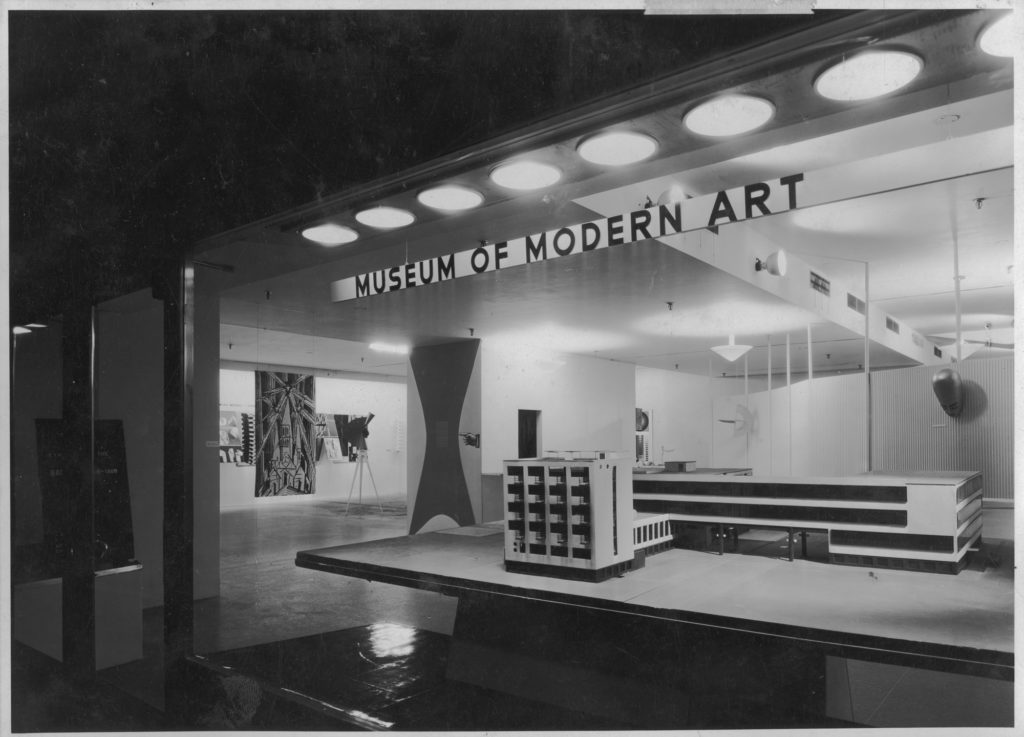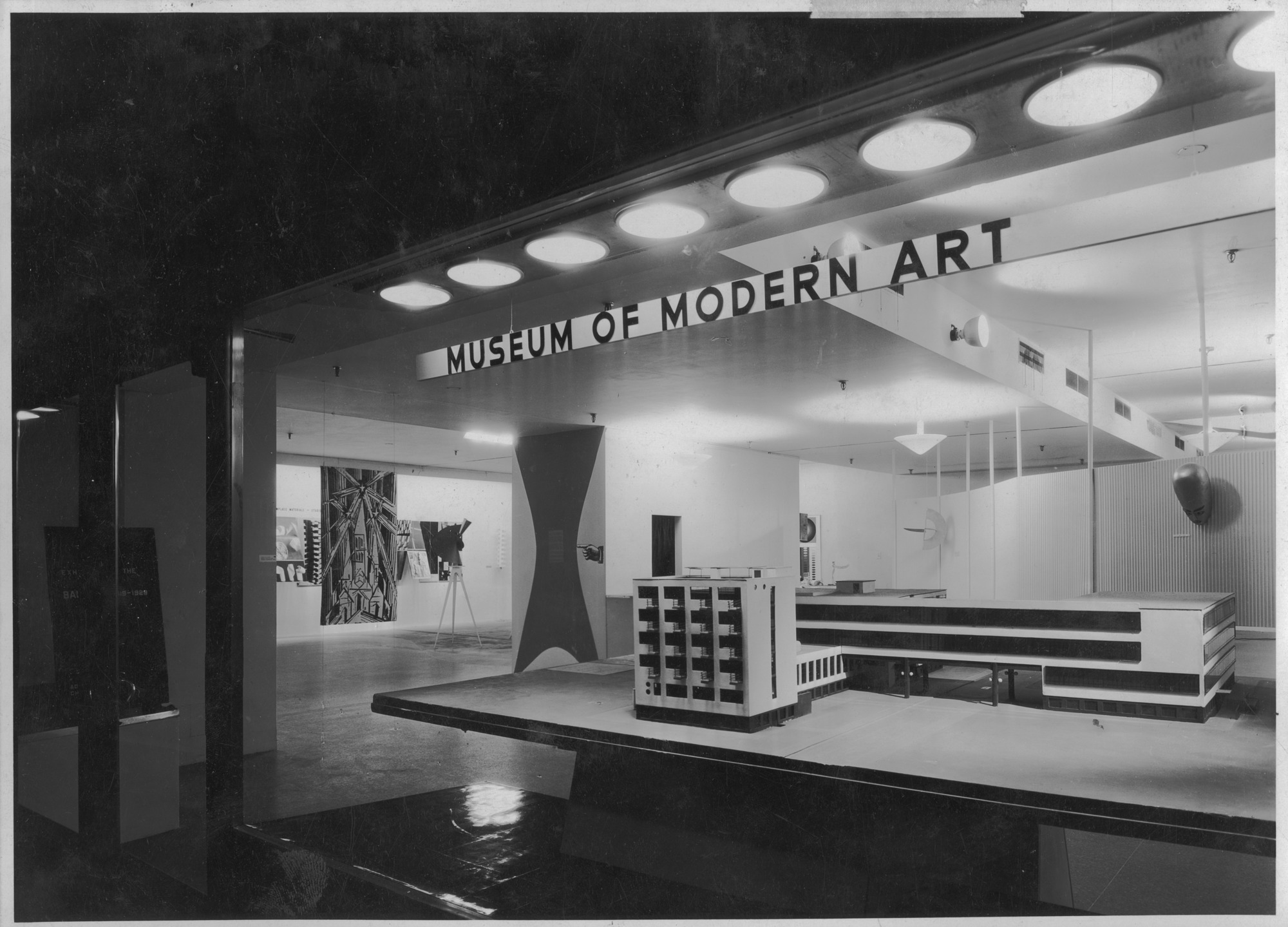[ad_1]

Installation view of “Bauhaus: 1919–1928,” 1938, at Museum of Modern Art, New York.
SOICHI SUNAMI/COURTESY MUSEUM OF MODERN ART
This year marks the 100th anniversary of the founding of the Bauhaus school in Weimar, Germany, and many institutions across the world have acknowledged the occasion with exhibitions devoted to the spare, functionalist forms of design, art, and architecture proffered by the school. With the centennial in mind, we turn back to the December 10, 1938 issue of ARTnews, which included a review of one of the first major Bauhaus surveys, held that year at the Museum of Modern Art in New York. At the time, the exhibition was one of the museum’s largest shows, and a release put out by MoMA also called it one of its “most unusual” outings. Writing on the exhibition, Martha Davidson criticized it for lacking the sense of unity and collaboration celebrated by many students of the Bauhaus. Her review follows below. —Alex Greenberger
“Epitaph Exhibit of the Bauhaus”
By Martha Davidson
December 10, 1938
Commemoration of a Famous Modern Source of Design
“Let us create a new guild of craftsmen, without the class distinctions which raise an arrogant barrier between craftsman and artist. Together let us conceive and create the new building of the future, which will embrace architecture and sculpture and painting in one unity and which will rise one day toward heaven from the hands of a million workers like the crystal symbol of a new faith.” Thus was the Bauhaus of Weimar launched by its first manifesto in 1919 under the courageous direction of Walter Gropius whose dream was a union of arts, crafts, trade and industry to best serve an industrialized civilization. Gropius envisaged the modern machine as a titanic vehicle for creative ideas, as a liberator from the obsolescent philosophy of art for art’s sake and, by its economics, as the bestower of freedom and order to modern society. Out of a world of chaos, a world torn by war, its economy in tatters and its aesthetics in Dadaist anarchy, a school was created as a vast workshop for apprentices and journeymen. Because of the hostility of the government of Thuringia the school was moved to Dessau in 1925 and later, in 1933, closed by the National Socialists. After the first nine years during which the Bauhaus principles were established and the character of the school determined, Gropius left for private practice. It is primarily to this early period, 1919-1928, that the current Bauhaus exhibition at the Museum of Modern Art is devoted.
The exhibition, better called an exposition, of the Werkstätten, a Festschrift to Gropius, and an epitaph to the Bauhaus (contrary to the emphatic denial stated in the preface to the catalogue), has been assembled and installed by Herbert Bayer, former student and master of typography at the schools of Weimar and Dessau. Purporting to demonstrate the Bauhaus principles of exhibition technique, the display is a maze through which the visitor is fruitlessly directed by means of guide lines, footprints and abstract designs painted on the museum floor. He is led, with little sense of continuity and none at all of the collaboration and unity of the complex of arts, through demonstrations of the training received by the Bauhäusler from the masters Itten, Klee, Kandinsky, Albers and Moholy-Nagy, through a series of expositions on the pottery, furniture, painting, weaving, topography, lighting fixtures, stagecraft, architecture and intimate, extracurricular activities of the Bauhaus. The exposition stuffers gravely through the absence of material examples. Because of the malevolent attitude of the Fatherland very few actual specimens of the crafts were available. The demonstration therefore consists largely of magnified photographs that, though decidedly inadequate, indicate the enormous scope of activities that constituted the training of every student that entered the school. Learn by doing was the inductive method preached by the Director who regarded the mastery of handicrafts as a stepping stone to machine industry, the antithesis of the principles followed in the eighties by William Morris whose reaction to the ugliness of the Industrial Age had led him to deny the machine as a medium for creative art. Like an enormous industrial laboratory the Bauhaus produced designs and models which were sold through the Bauhaus Corporation. Its influence spread widely throughout the industrialized world.
The curriculum of the school, outlined in the first room, recalls the early cries for functional art, for manual dexterity and for rational design in terms of techniques and materials. The exercises for the different courses frequently seem to be futilitarian and the experiments ingenious efforts within a cul de sac. Under the guise of “Composition. Exercise in combination of simplest plastic and rhythmic forms” (by N. Wassiljeff) the spirit of Dada stealthily entered the classroom. Although freedom of invention was urged, although the doctrinaire attitude of “the academy” was deplored, the powerful influence of the individualistic masters seems to have constrained the originality of their pupils in relation to the actual realization of exercises in the use of new materials made available by the machine. The produce of the Bauhaus is represented almost entirely by the masters and by the pupils, like Josef Albers, Bayer and Marcel Breuer who became teachers when the school was removed to Dessau. This situation poses the question: was the Bauhaus system, designed to foster flexibility and invention, properly attuned to create master craftsmen equipped to carry on the creative work of the great teachers and pioneers of Weimar by whom it was dominated? Apparently it was not.
High spots among the actual displays, besides the paintings of the celebrated artists Feininger, Klee, Kandinsky and the woodcuts of Gerhard Marcks, are the magnificent textiles by Anni Albers and Otti Berger, the historical first tubular chair by Breuer, the miniature abstract film by Moholy-Nagy and the peep show of the Triadic Ballet. The last, a pantomime of rotating fantastic automata in a mechanized drama created by Oskar Schlemmer, dramatically demonstrates the uses to which the machine may be put. Many of the exhibits stir up the question of functionalism which was one of the basic principles of the Bauhaus. Surely, as a thoroughly trained student, Bayer’s experiments with the properties of color should have prevented him from using the too intense red as the color for his explanatory labels. The false functionalism, obvious in this petty example, is indicative of the lapse between theory and practise which made the Bauhaus building designed by Gropius an inferno in the summer because of the glass cage which acted as a conductor of the sun’s heat.
The integration of the main branches of art promised in the Manifesto of 1919 was clearly never achieved. Thus America, despite her evident admiration for the historic importance of the Bauhaus, must look forward—rather than backward to an ideology based on naked and unencumbered art—to a functioning rather than a functional relation between architect, sculptor and painter.
[ad_2]
Source link

